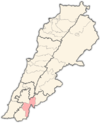Marjayoun District | |
|---|---|
District | |
 Al-Khiyam, Marjayoun District | |
 Location in Lebanon | |
| Coordinates: 33°21′43″N35°35′23″E / 33.36194°N 35.58972°E | |
| Country | |
| Governorate | Nabatiyeh Governorate |
| Capital | Marjayoun |
| Area | |
• Total | 102.4 sq mi (265.3 km2) |
| Elevation | 2,820 ft (860 m) |
| Population | |
• Estimate (31 December 2017) | 85,960 |
| Time zone | UTC+2 (EET) |
| • Summer (DST) | UTC+3 (EEST) |

The Marjayoun District is a district in the Nabatieh Governorate of Lebanon. The capital of the district is Marjayoun.
Contents
Marjayoun stands at a hill facing Mount Hermon to the East, with Beaufort Castle. The Litani River and Mount Amel are to the West, The Rihan, Niha and the Lebanon Mountain Range to the North and the fertile plains of Sahil Marjayoun that extends into Northern Israel between the Galilee finger and plains immediately underneath the Golan Heights.
